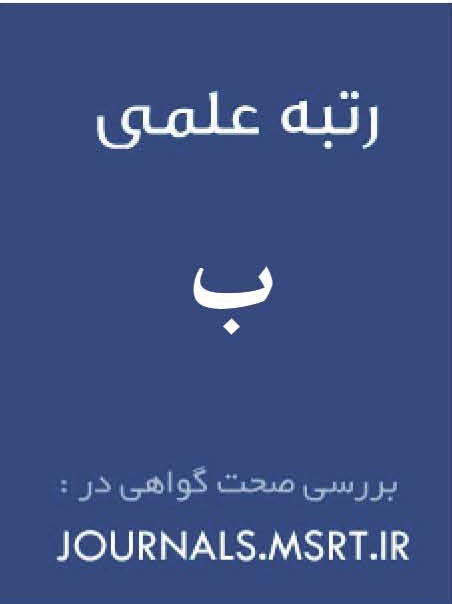ارزیابی رابطه علی میان نرخ ارز و نوسان آن با شاخص فلاکت در ایران
کلمات کلیدی:
آزمون علیت تحت شکستهای ساختاری, تقریب فوریه, شاخص فلاکت, نرخ ارزچکیده
شاخص فلاکت یک شاخص کلیدی برای ارزیابی وضعیت اقتصادی جامعه و اثرات آن بر رفاه مردم است. افزایش این شاخص نشانهای از تشدید مشکلات اقتصادی است که بر رفاه افراد جامعه تاثیر میگذارد. به همین دلیل شاخص فلاکت به عنوان یک ابزار مهم برای سیاستگذاران جهت اتخاذ تصمیمات مناسب جهت بهبود شرایط اقتصادی است. به ویژه در دورههای بحران و رکود اقتصادی، این شاخص به عنوان چراغ هشدار عمل کرده و ضرورت اتخاذ سیاستهای اصلاحی را بیش از پیش نمایان میسازد. یکی از متغیرهای اثرگذار بر شاخص فلاکت، نرخ ارز است. با توجه به اهمیت شاخص فلاکت و جهشهای ارز در چند سال گذشته پژوهش حاضر به ارزیابی رابطه علی بین نرخ ارز و نوسان آن با شاخص فلاکت در بازه زمانی بهار 1380 تا تابستان 1403 پرداخته است. با توجه به نوسانات اقتصادی متعدد در کشور و احتمال وقوع شکستهای ساختاری، در پژوهش حاضر از تقریب فوریه برای لحاظ شکستهای ساختاری در آزمونهای ایستایی متغیرها، همانباشتگی و علیت استفاده شده است. همچنین از روش GARCH برای برآورد عدم قطعیت نرخ ارز برای بررسی رابطه علی بین عدم قطعیت نرخ ارز و شاخص فلاکت استفاده شده است. نتایج بیانگر وجود رابطه علی یک طرفه از نرخ ارز به شاخص فلاکت و رابطه علی دو طرفه بین عدم قطعیت نرخ ارز و شاخص فلاکت است. بنابراین ناپایداری نرخ ارز میتواند آثار مخربی را بر رفاه اقتصادی مردم (شاخص فلاکت) بر جای گذارد و از آن جا که تکانههای خارجی عمدتاً از طریق نرخ ارز و نوسانات آن بر اقتصاد کشور و در نتیجه بر تورم و بیکاری تأثیر میگذارند، از همین رو توجه به تکانههای خارجی و پیشبینی آنها و استفاده از ابزارهایی که بتواند اقتصاد کشور را در مواجهه با آنها توانمند سازد از اولویت برخوردار است.
دانلودها
مراجع
Abdi Seyyed Kalaei, M., Mo'tameni, M., & Mosleh, H. (2025). The effect of exchange rate fluctuations on unemployment in MENA countries. Biannual Scientific Journal of Economic Studies and Policies.
Akarsu, G. (2020). Unemployment, exchange rate and exchange rate volatility relation: analysis for Turkey. Çankırı Karatekin University Journal of the Faculty of Economics and Administrative Science, 10(1), 179-209. https://doi.org/10.18074/ckuiibfd.626327
Alemu, F. M. (2025). An Empirical Analysis of the Nexus between Inflation, Exchange Rate, Unemployment and Economic Growth in Ethiopia: A Granger Casualty Approach. https://doi.org/10.1177/09750878241234254
Apergis, N., Bulut, U., Ucler, G., & Ozsahin, S. (2021). The causal linkage between inflation and inflation uncertainty under structural breaks: Evidence from Turkey. Manchester School, University of Manchester, 89(3), 259-275. https://doi.org/10.1111/manc.12361
Azzollini, L. (2023). Scar effects of unemployment on generalised social trust: The joint impact of individual and contextual unemployment across Europe. Social science research, 109, 102787. https://doi.org/10.1016/j.ssresearch.2022.102787
Bollerslev, T. (1986). Generalised autoregressive conditional heteroskedasticity. Journal of Econometrics, 31(2), 307-327. https://doi.org/10.1016/0304-4076(86)90063-1
Chang, S. C. (2011). The interrelationship between exchange-rate uncertainty and unemployment for South Korea and Taiwan: Evidence from a vector autoregressive approach. International Economics(125), 65-82. https://doi.org/10.1016/S2110-7017(13)60025-6
Devia, S. S. V. (2019). The correlation of exchange rate and inflation and its effect on stock markets: Case study on consumer good index Indonesia: 2004-2017. Academic Journal of Economic Studies, 5(2), 32-44.
Emikonel, M., & Orhan. (2023). An Empiric Analysis on the Relationship between Exchange Rates and Inflation in Fragile Five Countries. Journal of Yaşar University, 18(70), 237-251.
Enders, W., & Lee, J. (2012). A unit root test using a Fourier series to approximate smooth breaks. Oxford Bulletin of Economics and Statistics, 74(4), 574-599. https://doi.org/10.1111/j.1468-0084.2011.00662.x
Ersin, İ. (2024). Investigation of the Relationship Between Misery Index and Some Macroeconomic Factors in Turkey: Hacker and Hatemi-J (2006) Causality Test. JOEEP: Journal of Emerging Economies and Policy, 9(2), 119-128.
Hashimoto, K. I., Ono, Y., & Schlegl, M. (2023). Structural unemployment, underemployment, and secular stagnation. Journal of Economic Theory, 105641. https://doi.org/10.1016/j.jet.2023.105641
He, S. H. (2020). The Causal Relationship between Exchange Rate Volitility, Stock Price Volitility and Unemployment Rate in Czech Republic https://doi.org/10.1109/ICEMME51517.2020.00209
Ilmas, N., Amelia, M., & Risandi, R. (2022). Analysis of the effect of inflation and exchange rate on exports in 5-years Asean countries (years 2010- 2020). Jurnal Ekonomi Trisakti, 2(1), 121-132. https://doi.org/10.25105/jet.v2i1.13561
Krugman, P., & Taylor, L. (1978). Contractionary effects of devaluation. Journal of International Economics, 8, 445-456. https://doi.org/10.1016/0022-1996(78)90007-7
Li, J., & Enders, W. (2017). Flexible Fourier form for volatility breaks. Studies in Nonlinear Dynamics & Econometrics, 22(1), 1-19. https://doi.org/10.1007/s11071-016-2940-9
Naveed, H. M., HongXing, Y., Memon, B. A., Ali, S., Alhussam, M. I., & Sohu, J. M. (2023). Artificial neural network (ANN)-based estimation of the influence of COVID-19 Covid-19 on dynamic and emerging financial markets. Technological Forecasting and Social Change, 190, 122470. https://doi.org/10.1016/j.techfore.2023.122470
Nazlioglu, S., Gupta, R., & Bouri, E. (2020). Movements in international bond markets: The role of oil prices. International Review of Economics & Finance, 68(1), 47-58. https://doi.org/10.1016/j.iref.2020.03.004
Nyahokwe, O., & Ncwadi, R. (2013). Impact of Exchange Rate Volatility on Unemployment in South Africa. Mediterranean Journal of Social Sciences, 4(3), 109-120. https://doi.org/10.5901/mjss.2013.v4n3p109
Obayorı, J. B. (2020). Government Expenditure and Economic Discomfort in Nigeria: An ARDL Approach. Finance & Economics Review, 2(2), 1-12. https://doi.org/10.38157/finance-economics-review.v2i2.89
Okun, A. M. (1970). The Political Economy of Prosperity. The Brookings Institution.
Pendar, M., & Vafaei, A. (2019). Convergence of the misery index in selected countries of Iran's 2025 development outlook plan: The Najar and Ender approach. Journal of Macroeconomic Research, 14(27), 149-173.
Pirpour, H., & Samsami Mazra'e Akhound, H. (2025). Evaluating the effect of exchange rate fluctuations on core inflation using the stochastic Mundell-Fleming model and diagnosing the reciprocal relationship between exchange rate fluctuations and inflation deviations in Iran. Quantitative Economics.
Sha'banzadeh Khoshroudi, M., Gilanpour, O., Javdan, E., & Rafati, M. (2022). The impact of preferential exchange rate policy on food consumption in urban areas of Iran. Economic Research (Growth and Sustainable Development), 22(3), 129-155.
Shojaeipour Monfared, S., & Akın, F. (2017). The Relationship between Exchage Rates and Inflation: The Case of Iran. European Journal of Sustainable Development, 6(4), 329. https://doi.org/10.14207/ejsd.2017.v6n4p329
Svensson, L. E. O. (2000). Open-economy inflation targeting. Journal of International Economics, 50(1), 155-183. https://doi.org/10.1016/S0022-1996(98)00078-6
Vafaei, A., & Razvani, M. (2025). Investigating the factors affecting the misery index in Iran. Parliament and Economics, 2(1), 21-40.
Wu, P. C., Liu, S. Y., & Pan, S. C. (2014). Does Misery Index Matter for the Persistence of Health Spending? Evidence from OECD Countries. Social Indicators Research, 118(2), 893-910. https://doi.org/10.1007/s11205-013-0450-4
Yien, L., Abdullah, H., & Azam, M. (2017). Granger Causality Analysis between Inflation, Debt and Exchange Rate: Evidence from Malaysia. International Journal of Academic Research in Accounting, Finance and Management Sciences, 7(1), 189-196. https://doi.org/10.6007/IJARAFMS/v7-i1/2624
دانلود
چاپ شده
ارسال
بازنگری
پذیرش
شماره
نوع مقاله
مجوز
حق نشر 2025 الهام وفائی, مهدی پندار, محمد رضوانی (نویسنده)

این پروژه تحت مجوز بین المللی Creative Commons Attribution-NonCommercial 4.0 می باشد.









